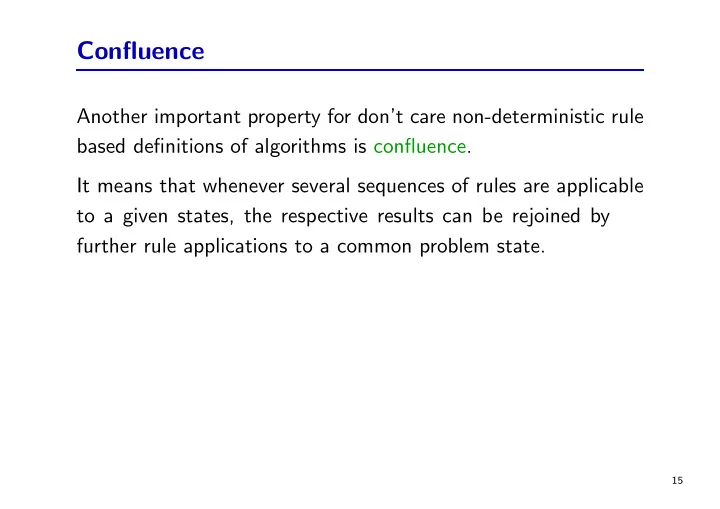

Confluence Another important property for don’t care non-deterministic rule based definitions of algorithms is confluence. It means that whenever several sequences of rules are applicable to a given states, the respective results can be rejoined by further rule applications to a common problem state. 15
Confluence Proposition 0.4 (Deduce and Conflict are Locally Confluent): Given a state ( N ; D ; ⊤ ) out of which two different states ( N ; D 1 ; ⊤ ) and ( N ; D 2 ; ⊥ ) can be generated by Deduce and Conflict in one step, respectively, then the two states can be rejoined to a state ( N ; D ′ ; ∗ ) via further rule applications. 16
Result It works. But: It looks like a lot of effort for a problem that one can solve with a little bit of thinking. Reason: Our approach is very general, it can actually be used to “pontentially solve” any problem in computer science. 17
Result This difference is also important for automated reasoning: • For problems that are well-known and frequently used, we can develop optimal specialized methods. ⇒ Algorithms & Data-structures • For new/unknown/changing problems, we have to develop generic methods that do “something useful”. ⇒ this lecture: Logic + Calculus + Implementation • Combining the two approaches ⇒ Automated Reasoing II (next semester): Logic modulo Theory + Calculus + Implementation 18
Topics of the Course Preliminaries math repetition computer science repetition orderings induction (repetition) rewrite systems Propositional logic logic: syntax, semantics calculi: superposition, CDCL implementation: 2-watched literal, clause learning 19
Topics of the Course First-order predicate logic logic: syntax, semantics, model theory calculus: superposition implementation: sharing, indexing First-order predicate logic with equality equational logic: unit equations calculus: term rewriting systems, Knuth-Bendix completion implementation: dependency pairs first-order logic with equality calculus: superposition implementation: rewriting 20
Literature Is a big problem, actually you are the “guinea-pigs” for a new textbook. Franz Baader and Tobias Nipkow: Term rewriting and all that , Cambridge Univ. Press, 1998. (Textbook on equational reasoning) Armin Biere and Marijn Heule and Hans van Maaren and Toby Walsh (editors): Handbook of Satisfiability , IOS Press, 2009. (Be careful: Handbook, hard to read) Alan Robinson and Andrei Voronkov (editors): Handbook of Automated Reasoning , Vol I & II, Elsevier, 2001. (Be careful: Handbook, very hard to read) 21
Part 1: Preliminaries • math repetition • computer science repetition • orderings • induction (repetition) • rewrite systems 22
1.1 Mathematical Prerequisites N = { 0, 1, 2, . . . } is the set of natural numbers N + is the set of positive natural numbers without 0 Z , Q , R denote the integers, rational numbers and the real numbers, respectively. 23
Multisets Given a set M , a multi-set S over M is a mapping S : M → N , where S specifies the number of occurrences of elements m of the base set M within the multiset S . We use the standard set notations ∈ , ⊂ , ⊆ , ∪ , ∩ with the analogous meaning for multisets, e.g., ( S 1 ∪ S 2 )( m ) = S 1 ( m ) + S 2 ( m ). We also write multi-sets in a set like notation, e.g., the multi-set S = { 1, 2, 2, 4 } denotes a multi-set over the set { 1, 2, 3, 4 } where S (1) = 1, S (2) = 2, S (3) = 0, and S (4) = 1. A multi-set S over a set M is finite if { m ∈ M | S ( m ) > 0 } is finite. In this lecture we only consider finite multi-sets. 24
Relations An n -ary relation R over some set M is a subset of M n : R ⊆ M n . For two n -ary relations R , Q over some set M , their union ( ∪ ) or intersection ( ∩ ) is again an n -ary relation, where R ∪ Q := { ( m 1 , . . . , m n ) ∈ M | ( m 1 , . . . , m n ) ∈ R or ( m 1 , . . . , m n ) ∈ Q } R ∩ Q := { ( m 1 , . . . , m n ) ∈ M | ( m 1 , . . . , m n ) ∈ R and ( m 1 , . . . , m n ) ∈ Q } . A relation Q is a subrelation of a relation R if Q ⊆ R . 25
Relations The characteristic function of a relation R or sometimes called predicate indicates membership. In addition of writing ( m 1 , . . . , m n ) ∈ R we also write R ( m 1 , . . . , m n ). So the predicate R ( m 1 , . . . , m n ) holds or is true if in fact ( m 1 , . . . , m n ) belongs to the relation R . 26
Words Given a nonempty alphabet Σ the set Σ ∗ of finite words over Σ is defined by (i) the empty word ǫ ∈ Σ ∗ (ii) for each letter a ∈ Σ also a ∈ Σ ∗ (iii) if u , v ∈ Σ ∗ so uv ∈ Σ ∗ where uv denotes the concatenation of u and v . 27
Words The length | u | of a word u ∈ Σ ∗ is defined by (i) | ǫ | := 0, (ii) | a | := 1 for any a ∈ Σ and (iii) | uv | := | u | + | v | for any u , v ∈ Σ ∗ . 28
Recommend
More recommend